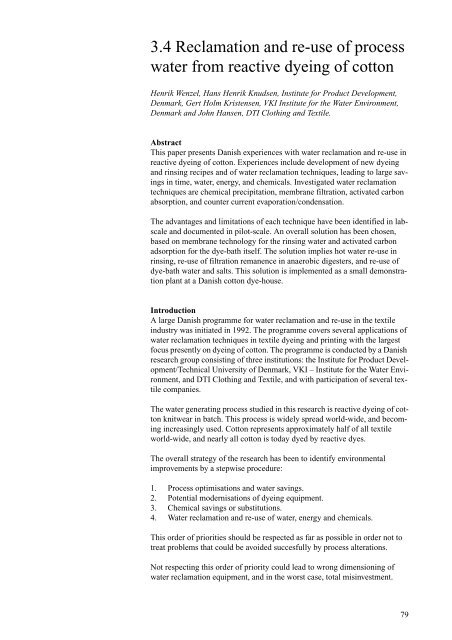Cleaner Technology Transfer to the Polish Textile ... - Miljøstyrelsen
Cleaner Technology Transfer to the Polish Textile ... - Miljøstyrelsen
Cleaner Technology Transfer to the Polish Textile ... - Miljøstyrelsen
Create successful ePaper yourself
Turn your PDF publications into a flip-book with our unique Google optimized e-Paper software.
3.4 Reclamation and re-use of process<br />
water from reactive dyeing of cot<strong>to</strong>n<br />
Henrik Wenzel, Hans Henrik Knudsen, Institute for Product Development,<br />
Denmark, Gert Holm Kristensen, VKI Institute for <strong>the</strong> Water Environment,<br />
Denmark and John Hansen, DTI Clothing and <strong>Textile</strong>.<br />
Abstract<br />
This paper presents Danish experiences with water reclamation and re-use in<br />
reactive dyeing of cot<strong>to</strong>n. Experiences include development of new dyeing<br />
and rinsing recipes and of water reclamation techniques, leading <strong>to</strong> large savings<br />
in time, water, energy, and chemicals. Investigated water reclamation<br />
techniques are chemical precipitation, membrane filtration, activated carbon<br />
absorption, and counter current evaporation/condensation.<br />
The advantages and limitations of each technique have been identified in labscale<br />
and documented in pilot-scale. An overall solution has been chosen,<br />
based on membrane technology for <strong>the</strong> rinsing water and activated carbon<br />
adsorption for <strong>the</strong> dye-bath itself. The solution implies hot water re-use in<br />
rinsing, re-use of filtration remanence in anaerobic digesters, and re-use of<br />
dye-bath water and salts. This solution is implemented as a small demonstration<br />
plant at a Danish cot<strong>to</strong>n dye-house.<br />
Introduction<br />
A large Danish programme for water reclamation and re-use in <strong>the</strong> textile<br />
industry was initiated in 1992. The programme covers several applications of<br />
water reclamation techniques in textile dyeing and printing with <strong>the</strong> largest<br />
focus presently on dyeing of cot<strong>to</strong>n. The programme is conducted by a Danish<br />
research group consisting of three institutions: <strong>the</strong> Institute for Product Development/Technical<br />
University of Denmark, VKI – Institute for <strong>the</strong> Water Environment,<br />
and DTI Clothing and <strong>Textile</strong>, and with participation of several textile<br />
companies.<br />
The water generating process studied in this research is reactive dyeing of cot<strong>to</strong>n<br />
knitwear in batch. This process is widely spread world-wide, and becoming<br />
increasingly used. Cot<strong>to</strong>n represents approximately half of all textile<br />
world-wide, and nearly all cot<strong>to</strong>n is <strong>to</strong>day dyed by reactive dyes.<br />
The overall strategy of <strong>the</strong> research has been <strong>to</strong> identify environmental<br />
improvements by a stepwise procedure:<br />
1. Process optimisations and water savings.<br />
2. Potential modernisations of dyeing equipment.<br />
3. Chemical savings or substitutions.<br />
4. Water reclamation and re-use of water, energy and chemicals.<br />
This order of priorities should be respected as far as possible in order not <strong>to</strong><br />
treat problems that could be avoided succesfully by process alterations.<br />
Not respecting this order of priority could lead <strong>to</strong> wrong dimensioning of<br />
water reclamation equipment, and in <strong>the</strong> worst case, <strong>to</strong>tal misinvestment.<br />
79

















